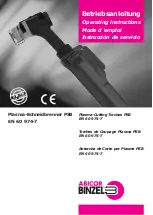
9
Handle
– Rugged, top mounted handle
allows for easy transport of your welder.
Wire Speed Control
– Use this dial to adjust
the speed at which the welder feeds wire to
the torch. 1 is the slowest wire feed speed, 10
is the highest. You will need to adjust or “tune-
in” your wire speed for different welding condi-
tions (thickness of metals, metal type, wire
size, etc.). When the wire speed is properly
“tuned-in” the welding wire will melt into the
material you are welding as quickly as it is fed
through the welding torch.
Voltage Selector
– This two position switch
adjusts the voltage or “heat” of your welder.
Select MIN setting for lower voltage and
MAX setting for higher voltage. Different
materials and material thickness will require
different voltage settings. You will need to
adjust your voltage accordingly for different
welding conditions. By properly adjusting
your voltage settings and wire feed speed,
you will enable clean, precision welds.
Power Switch
– This switch turns the welder
ON and OFF. (Make sure the power switch is
in the OFF position before performing any
maintenance on the welder.)
Power Cord
– This is a standard, grounded
120 volt power cord. (Make sure you are
using a properly grounded 120 Vac, 60Hz,
single phase, 20 amp power source.)
Ground Clamp
– Attaching the ground
clamp to your work piece “completes” the
welding current circuit. You must attach the
ground clamp to the metal you are welding. If
the ground clamp is not connected to the
metal work piece you intend to weld, the
welder will not have a completed circuit and
you will be unable to weld. A poor connection
at the ground clamp will waste power and
heat. Scrape away dirt, rust, scale, oil or
paint before attaching the ground clamp.
Ground Cable
– The ground cable connects
the ground clamp to the internal workings of
the welder.
Welding Torch and Cable
– The welding
torch controls the delivery of the welding wire
to the material to be welded. The welding
wire is fed through the welding cable and
welding torch when the welding torch trigger
is pulled. You will need to install a contact tip
and welding nozzle to the end of the welding
torch, as described later in this manual, prior
to welding.
Circuit Breaker
– This unit is equipped with
a circuit breaker switch which protects the
welder’s power supply from line voltage
surges. If circuit breaker is tripped, reset by
pressing the button located inside the access
panel on the dividing wall of the welder.
Welding Terms -
Now that you are familiar
with the main parts of the welder, make note
of the following terms. You will see them
used throughout this manual.
weld puddle:
The localized volume
of molten metal in a weld prior to its
solidification.
weld angle:
The angle of the welding wire,
as it extends from the welding torch, in rela-
tion to the item being welded.
slag:
The protective coating that forms on
the surface of molten metal.
arc:
A sustained luminous discharge of elec-
tricity across a gap in a circuit.
welding bead:
The extended build up of a
weld, made by pushing or pulling the weld
puddle.
KNOW YOUR WELDER
Figure 1.
Model WE6482 Welder
Summary of Contents for MMIG125
Page 8: ......
Page 23: ......
Page 24: ...24 TABLE 5 TROUBLESHOOTING ...
Page 25: ...25 MMIG125 WIRING DIAGRAM ...
Page 26: ......
Page 27: ...27 1 888 287 6981 ...










































